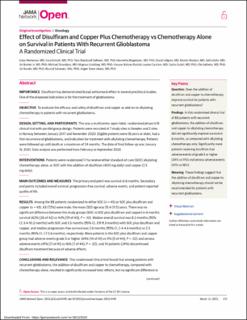| dc.description.abstract | Importance Disulfiram has demonstrated broad antitumoral effect in several preclinical studies. One of the proposed indications is for the treatment of glioblastoma.
Objective To evaluate the efficacy and safety of disulfiram and copper as add-on to alkylating chemotherapy in patients with recurrent glioblastoma.
Design, Setting, and Participants This was a multicenter, open-label, randomized phase II/III clinical trial with parallel group design. Patients were recruited at 7 study sites in Sweden and 2 sites in Norway between January 2017 and November 2020. Eligible patients were 18 years or older, had a first recurrence of glioblastoma, and indication for treatment with alkylating chemotherapy. Patients were followed up until death or a maximum of 24 months. The date of final follow-up was January 15, 2021. Data analysis was performed from February to September 2022.
Interventions Patients were randomized 1:1 to receive either standard-of-care (SOC) alkylating chemotherapy alone, or SOC with the addition of disulfiram (400 mg daily) and copper (2.5 mg daily).
Main Outcomes and Measures The primary end point was survival at 6 months. Secondary end points included overall survival, progression-free survival, adverse events, and patient-reported quality of life.
Results Among the 88 patients randomized to either SOC (n = 45) or SOC plus disulfiram and copper (n = 43), 63 (72%) were male; the mean (SD) age was 55.4 (11.5) years. There was no significant difference between the study groups (SOC vs SOC plus disulfiram and copper) in 6 months survival (62% [26 of 42] vs 44% [19 of 43]; P = .10). Median overall survival was 8.2 months (95% CI, 5.4-10.2 months) with SOC and 5.5 months (95% CI, 3.9-9.3 months) with SOC plus disulfiram and copper, and median progression-free survival was 2.6 months (95% CI, 2.4-4.6 months) vs 2.3 months (95% CI, 1.7-2.6 months), respectively. More patients in the SOC plus disulfiram and copper group had adverse events grade 3 or higher (34% [14 of 41] vs 11% [5 of 44]; P = .02) and serious adverse events (41% [17 of 41] vs 16% [7 of 44]; P = .02), and 10 patients (24%) discontinued disulfiram treatment because of adverse effects.
Conclusions and Relevance This randomized clinical trial found that among patients with recurrent glioblastoma, the addition of disulfiram and copper to chemotherapy, compared with chemotherapy alone, resulted in significantly increased toxic effects, but no significant difference in survival. These findings suggest that disulfiram and copper is without benefit in patients with recurrent glioblastoma.
Trial Registration ClinicalTrials.gov Identifier: NCT02678975; EUDRACT Identifier: 2016-000167-16 | en_US |

